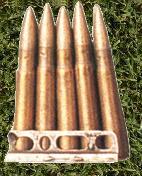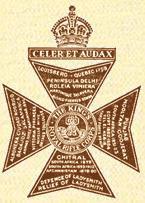




TRADITIONS OF THE KRRC
The Traditions of the regiment derive from the tasks which it has been called upon to perform during two centuries of continuous service, frequently in new and original roles and from the influence of those who have served in it.
The regiment was first raised in America in 1755 as the 62nd (soon afterwards the 60th) Royal American regiment recruited largely from American Colonists. Britain and France were not at war, however the attitude was tense and unstable and the French actively supported the Red Indians who were involved in several skirmishes with us. The Regiment, of four battalions each 1,000 strong was formed to save a critical situation. The Red coats, ponderous movements and formal tactics of the British forces at the time had failed disastrously against the more mobile French troops and Red Indians in the dense forests and trackless wastes of North America.
To meet these novel conditions the 1st Battalion, 60th Royal Americans adopted a light, inconspicuous uniform and equipment, a simple drill, open formations and rapid movement. Personal initiative was encouraged and a more tolerant discipline was adopted. These clearly marked out the 60th from the rest of the 18th century British Army. Very soon, three other battalions had been formed to follow suit.
In 1797 the 5th battalion was formed as the first rifle battalion in the British army. The 60th’s sister brigade, the 95th, later the Rifle Brigade, was formed shortly afterwards. Together these two regiments were known as the Green Jackets. They fought together on many occasions up until their merging, along with the Oxfordshire and Buckinghamshire Light Infantry, to form the Royal Green Jacket Regiment in 1966. The Green Jackets were distinguished by their green (rather than red) uniforms, special and adaptive tactics and drills controlled by bugle calls (the bugle later became the Green Jackets’ symbol).
The Tradition of speed is still reflected in the quick march of 140 paces to the minute and the double march of 180 paces to the minute. The Regiments were armed with sword and rifle rather than musket and bayonet. To reflect this, bayonets in the regiment are referred to as “swords” and never fixed on parade.
The 60th fought in small groups, attached to larger units; scouting and skirmishing in the forefront. They co-operated with other units and acted with initiative and speed. “The Green Jackets” became a name synonymous with Accuracy in shooting and development of new methods of fighting.
The name “corps” is used because the Regiment included several, normally four battalions. The word “regiment” implies only one or two battalions. At the time of the Second World War, His Majesty the King was the Colonel-in-Chief of the corps. There are no regimental colours as they would be unsuitable in a scouting role. The regimental battle honours were therefore worn on the regimental cap badge and the officer's cross-belt badge.
The unit centred its recruitment in Britain after the betraya… erm… ‘gaining of independence’ of the American colonists. After 1881, recruitment has been centered around London. Today the unit forms part of the Royal Green Jackets Regiment, which follows the traditions of the unit.
Adapted with permission by David Blatcher from “The King’s Royal Rifle Corps (60th Rifles) Bicentenary Edition”, published 1955, which was kindly supplied by Colonel I H McCausland of the Celer et Audax club.
